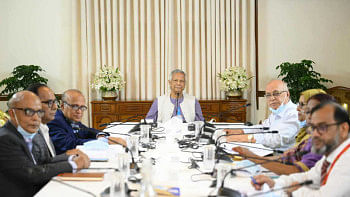ASEAN should not drop the ball

A few days ago, I sat down with Mr. Dwight Hutchins, chairman of the American Chamber of Commerce (AmCham) in Singapore, to discuss the chamber's 2017 ASEAN Business Outlook Survey. Published in collaboration with the US Chamber of Commerce and conducted on behalf of companies from a nation that is the largest investor in South-east Asia, the document makes for interesting reading.
More than half of the US firms reported that ASEAN markets had become more important over the past two years in terms of their worldwide revenue. That's chiefly because of the brisk pace of economic growth here, added to a rising middle class and an expanding consumer class, and regional integration. Nearly nine out of 10 companies anticipated that their level of trade and investment in ASEAN would increase over the next five years.
Topping the list of ASEAN states where US companies were the most optimistic because of an improving business climate were the Philippines, Vietnam and Myanmar. The last two, along with Indonesia, were priority markets for expansion.
Interestingly, for US companies that are in Cambodia and Laos, regional integration was the strongest reason for the growing importance of ASEAN markets.
And it is not just the Americans. The Japanese, who are nearly as big an exporter of capital, also are turning back to South-east Asia. In 2015, for a third straight year, the amount of foreign direct investment from Japan to the ASEAN states exceeded such investment in China and Hong Kong, according to the Japan External Trade Organisation.
The Japan Bank for International Cooperation (JBIC) says about 56 percent of Japanese firms are looking to expand in ASEAN in the next three years. Just as significantly, the share of Japanese companies looking to invest in China had fallen below 50 percent, from 73 percent in 2011.
Analysts have been aware of these trends for a while. Indeed, they have noticed that the pace is accelerating. In March, for instance, DBS Group Research pointed out that Japanese investment flows to the so-called ASEAN Six (Singapore, Thailand, Malaysia, Indonesia, Philippines and Vietnam) had averaged US$20 billion (S$26.9 billion) per year for the past five years, with the exception of 2012, when flooding in Thailand caused a drop in flows to the country. In contrast, the 2006-2010 period had seen flows of just US$7 billion to US$10 billion.
What began as a mere risk dilution strategy in the boardrooms of Tokyo and Osaka seems to have evolved into something bigger and healthier, one based on South-east Asia's inherent attractiveness. The AmCham survey and the JBIC report merit the attention of not just the business people of ASEAN but its government leaders as well, coming as they do at a time of both opportunity and challenge for South-east Asia.
In China, American companies are finding the business environment steadily more difficult and profits are dipping year by year. In one of the extreme cases, Uber, the car-hailing firm, has just thrown in the towel, surrendering to a combination of stiff competition from a domestic player and regulations that work against its model. The story is repeated across many industries. Little wonder that a tenth of American companies in China are looking to diversifying from the mainland and into ASEAN.
But, if political risk and a slowing economy in China are opening significant opportunities for ASEAN companies to capitalise on, fresh challenges are rising nearby as well.
Last week in India, the government managed to successfully steer through tax legislation that holds the promise of turning the vast land into a single market for production and distribution. That is an unquestioned boon to investors, and of course, Indians themselves. But an India rising in attractiveness for investors can be a formidable challenge for South-east Asian economies because its economy, unlike China's which is steadily and deliberately moving up the value chain, will compete with them at every section of the scale.
From the low-skilled garment industry jobs that have moved to Cambodia and Myanmar to those that require higher skills, including weapons manufacture, all of them can be done in India, sometimes at lower cost. And it is not about just wages only. Productivity in India has been rising by nearly 4 percent per year. Equally, it also has the stout strategic backing of the US and Japanese governments, both of which clearly want the nation to succeed.
ASEAN would never wish to see a neighbouring nation, whether China or India, beggared. That said, if ever there was a time that it should, as a bloc, put its 10 heads together and coordinate its steps in every way, it is now. There's so much going for it – the Asian Development Bank says ASEAN's intra-regional trade intensity index was 3.54 in 2014, higher than the European Union's 2.04 and East Asia's 1.54 – that it would be foolish to not keep a good thing going.
Yet, the integration that is so key to the future of South-east Asia may well be at risk. The consensus-based grouping that charmed the world and succeeded in convincing most outside powers to grant it the "centrality" it sought, is in danger of dropping the ball as internal fissures surface all too often.
A decade ago, the issue that nearly collapsed an ASEAN summit was Myanmar's steadfast refusal to let a United Nations Special Envoy brief its summit on the progress he was making as a mediator between the junta and the democratic opposition. Today, that seems like a mere hiccup. Myanmar, happily enough, now has an elected government and is increasingly rising on the radar of global investors. Since 2012, though, the dissonance has become more serious and a lot of it has stemmed from the actions of Cambodia, ASEAN's youngest member, and its anxiety to please China.
Four years ago as host nation for the Asean summit, its refusal to countenance references to the South China Sea in the conference document led to the unprecedented situation where a summit ended without the usual joint statement. Last month, in Vientiane, it again successfully fended off direct references to China, even though it is itself not a party to the dispute. What's more, the meeting was held in the aftermath of a decisive ruling against China from the arbitration tribunal at The Hague.
The US$600 million grant that Cambodia received a week before the Vientiane meeting may be useful for it today, but the political payoffs involved may not be worth the price, long-term. Indeed, some senior ASEAN diplomats even took to social media to suggest Cambodia should be asked to leave ASEAN.
There was a time when ASEAN's fault lines used to be regarded broadly as those between the mainland states of South-east Asia and the maritime ones. As the big powers jockey for influence in the region, and open their pocketbooks to press their influence, more fissures must be expected. Already, there is some moderation of expectations going on: See how the language on an ASEAN Economic Community has changed. Not too long ago, the pitch was about developing a single market and production base. These days, we seem happier with less ambitious formulations such as striving for a "highly integrated economy".
To hang together holds the promise of a shared future of prosperity. As the AmCham survey indicates, quite a bit of the interest overseas companies have in being here stems from South-east Asia's efforts to integrate, not stand separately. This is something to think about.
The writer is Associate Editor (Global Affairs), The Straits Times, Singapore. This is the seventh article in a series of columns on global affairs written by top editors from members of the Asia News Network and published in newspapers across the region.

 For all latest news, follow The Daily Star's Google News channel.
For all latest news, follow The Daily Star's Google News channel. 



Comments